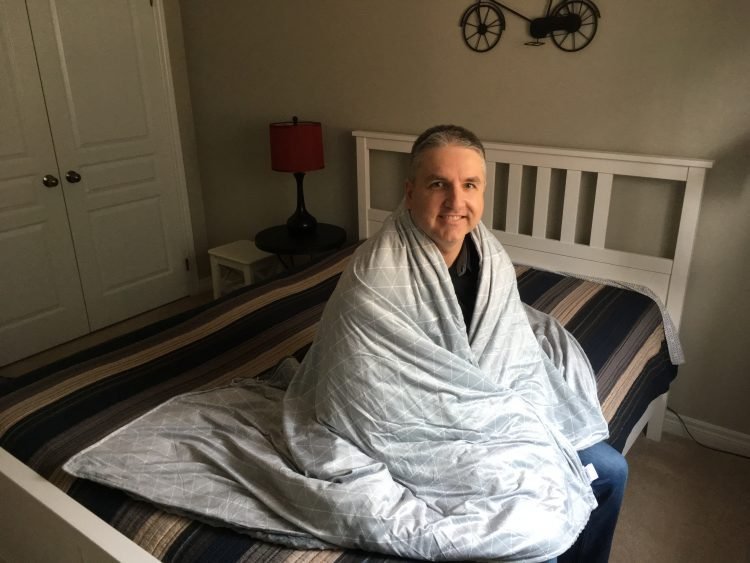People with attention deficit hyperactivity disorder (ADHD) struggle with inattention, hyperactivity, and impulsiveness. This is true of children trying to pay attention, sit still, and behave appropriately in class, or adults trying to focus on a task at work.
If you have ADHD, you know how difficult it can be to manage, even with medication, so anything that helps, without risk or side effects is probably worth a try.
Weighted blankets are one such tool in managing ADHD. They have the advantage of being completely safe, relatively inexpensive, and most importantly, can be used when, if, and to the extent that they are needed, at your own discretion.
Weighted blankets help people with ADHD primarily by providing deep touch pressure, the kind of firm touch we associate with a hug or massage. We experience deep touch pressure throughout our lives and don’t even realize it.

As newborns in the hospital nursery, the nurses swaddle us in tight blankets. As babies, our parents rock us or pace the floor, holding us close and patting us firmly. When we get a little older, they tuck our sheets and blankets securely around us.
We grow up and pay massage therapists to push and rub and knead our bodies, and all through our lives, we turn to comforting hugs from those we love. All this provides deep touch pressure. Some people crave this kind of touch more than others. If you have ADHD and this sounds familiar, there may be a reason.
According to Science Daily, people with ADHD are more likely to suffer from sensory processing disorder, a condition where the nervous system is under or oversensitive to light, smell, noise or touch.
How often are kids with ADHD told that they are talking too loud or invading someone’s personal space? These kids chew on pencils, fidget in their seats, climb, jump, twirl and frequently bump into things, or people.
This can be because they are under sensitive to sensory stimulation and are seeking more sensation, more sensory input for a brain that isn’t getting enough information from the outside world. These kids are literally bouncing off the wall because hitting the wall with their bodies feels good.
As an adult, sensory seeking may be the force behind driving too fast or being too loud and impulsive at the office party.
Occupational therapists treat patients with sensory processing disorder by applying deep touch stimulation in a variety of ways. They might make a sandwich of the patient with exercise mats, roll a ball over them, or wrap them up like a burrito.
Some individuals intuitively know what they need and gravitate toward fairly tight clothes that apply a level of constant pressure. And a preliminary study by the National Institute of Health showed that deep pressure, in the form of a weighted vest, increased on-task behavior in students with ADHD.

Weighted blankets are a great way to provide sensory stimulation in the form of deep touch pressure, and they provide other sensory input as well. If you have ADHD, how might a weighted blanket help you?
Weighted Blankets Help Ground You
In this context, grounded means being aware of, and fully present in, the here and now. Anything that reminds you of your immediate physical surroundings can ground you. Grounding exercises are often used to help people with post-traumatic stress disorder (PTSD) and anxiety disorders.
Being grounded helps them put aside thoughts of past trauma, or future worries, and concentrate on immediate physical sensations. As a result, the person is grounded in reality and becomes calmer and more able to think rationally.
Just like PTSD, ADHD can cause considerable anxiety because you know what teachers and bosses expect, and you feel that you fall short of those expectations.
This stress starts a cycle of increasing agitation and impulsive behavior, which makes you less able to do your job, whether that is work or school, and therefore you feel worse, worry more, and the anxiety cycle continues
A weighted blanket provides a variety of sensory stimulation that helps ground you in the present moment.
The deep touch pressure and warmth that a blanket’s weight provides, along with the tactile sensations from the fabric’s texture, and the visual input from its color and pattern, all direct your attention to positive physical sensations that you are experiencing in the moment and ground you in the present.
This creates a calmer state and the ability to stop and apply whatever therapeutic techniques you have learned. Weighted blankets can also help with a specific function of the nervous system.
Aid in Proprioception
Proprioception stated simply, is the ability to know where your body is, and what it is doing. If you have ever had your leg “go to sleep”, and then nearly fallen when you stood up, the problem was proprioception.

Your leg was supporting you just fine, but you couldn’t feel it, so you couldn’t balance. Proprioception is the constant information that we react to subconsciously, in order to operate our bodies, especially our limbs, without seeing what they are doing with our eyes.
If you feel too much pressure on your toes, for instance, you subconsciously sense that you are leaning forward, and you lean back to compensate and thereby stay balanced. When proprioception is blocked, by numbness or an injury, or is not working correctly, we lack the information we need to carry out various coordinated activities.
If you or your child has ADHD with accompanying sensory issues, your proprioception may be off kilter. How can this affect you?
If you don’t have a good sense of how fast you are walking, or how firmly you are grasping a pencil, or how near you are to the chair as you lower yourself onto it, this poor sense of proprioception can make you clumsy or awkward.
You might shake someone’s hand too hard, or your child might find it difficult to balance well enough to ride a bike. How can a weighted blanket help?
The weight that the blanket provides can actually calm your nervous system by providing adequate feedback, which in turns aids in proprioception. You can more clearly discern your body’s position in space because the added pressure helps you actually feel it more distinctly.
You feel more secure and anchored while you are using the blanket and at the same time, your nervous system is learning how to better receive input from your sense of touch and detect nuances in pressure and movement. Even later you may be more clearly oriented to your body and its surroundings.
Conclusion – Transition to Sleep Is Easier
It’s no secret that ADHD affects sleep. Most commonly it disrupts the ability to get to sleep and stay asleep. Sleeping with a weighted blanket, for all the reasons listed above, quiets a restless nervous system and promotes a secure mood, conducive to sleep.
Throughout the night, it applies gentle pressure on your skin and joints, reassuring your body of where it is, and helps you to sleep like a swaddled baby.

